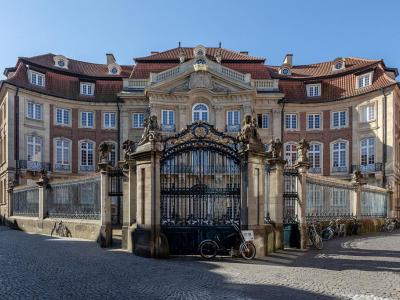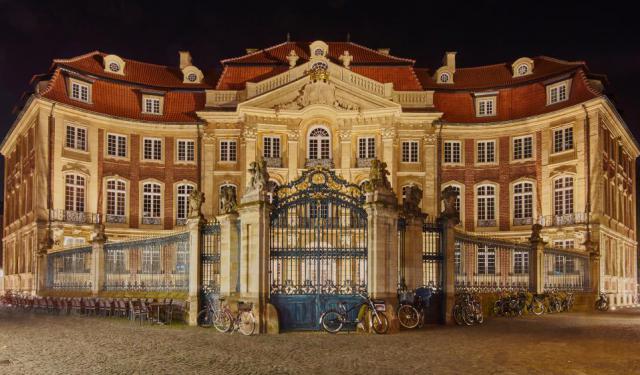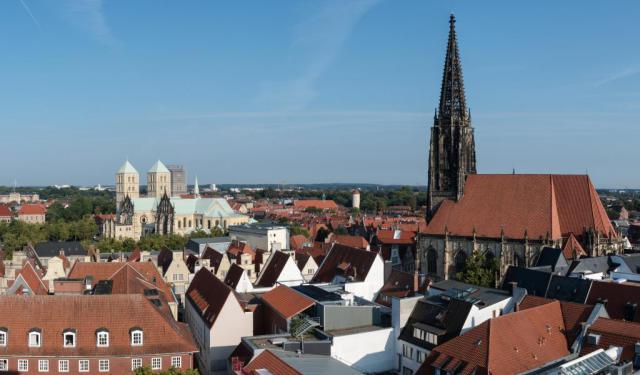
Erbdrostenhof, Munster
One of the most beautiful pieces of architecture in Münster, the palace of Erbdrostenhof forms part of the city's so-called “baroque island”, together with the Clemenskirche and Dominikanerkirche (Clemens and Dominican churches).
This aristocratic property was built between 1753 and 1757 to a design by Baroque architect, Johann Conrad Schlaun, and was commissioned by the Erbdrosten (Prince-Bishop) of Munster, Adolf Heidenreich Freiherr Droste zu Vischering. The three-winged building is quite remarkable for its imposing design, especially considering the limited floor space available to it. The sculptural part of the palace was done by Johann Christoph Manskirch, and the frescoes were painted by Nikolaus Loder.
The building is also notable as the birthplace of Blessed Mary of the Divine Heart (born Maria Droste zu Vischering, on 8 September 1863), who was a German noblewoman and Roman Catholic religious sister of the Congregation of Our Lady of Charity of the Good Shepherd. She is best known for having influenced Pope Leo XIII to consecrate the world to the Sacred Heart of Jesus, which the Pope himself considered the greatest act of his pontificate.
Largely destroyed during World War II, the property was painstakingly restored between 1953 and 1970. For many years after the war, the Erbdrostenhof housed the Westphalian Office for the Preservation of Monuments. Following that, a number of other cultural organizations have quartered within its walls, including the Historical Commission and the Literature Commission for Westphalia, the Droste Research Center, and, finally, the LWL Museum Office (the current occupants, who leased the property until 2057).
The LWL maintains a collection of exquisite historical keyboard instruments in the Erbdrostenhof as part of the local cultural heritage maintenance. Among the stored items here, perhaps one of the most valuable is a three-course, two-manual Ruckers harpsichord from 1640 (recognized as one of the most important historical keyboard instruments in the world), loaned by the Count of Landsberg-Velen. The instruments are presented to the public every year during the "Erbdrostenhof concerts" organized in cooperation with the city administration.
This aristocratic property was built between 1753 and 1757 to a design by Baroque architect, Johann Conrad Schlaun, and was commissioned by the Erbdrosten (Prince-Bishop) of Munster, Adolf Heidenreich Freiherr Droste zu Vischering. The three-winged building is quite remarkable for its imposing design, especially considering the limited floor space available to it. The sculptural part of the palace was done by Johann Christoph Manskirch, and the frescoes were painted by Nikolaus Loder.
The building is also notable as the birthplace of Blessed Mary of the Divine Heart (born Maria Droste zu Vischering, on 8 September 1863), who was a German noblewoman and Roman Catholic religious sister of the Congregation of Our Lady of Charity of the Good Shepherd. She is best known for having influenced Pope Leo XIII to consecrate the world to the Sacred Heart of Jesus, which the Pope himself considered the greatest act of his pontificate.
Largely destroyed during World War II, the property was painstakingly restored between 1953 and 1970. For many years after the war, the Erbdrostenhof housed the Westphalian Office for the Preservation of Monuments. Following that, a number of other cultural organizations have quartered within its walls, including the Historical Commission and the Literature Commission for Westphalia, the Droste Research Center, and, finally, the LWL Museum Office (the current occupants, who leased the property until 2057).
The LWL maintains a collection of exquisite historical keyboard instruments in the Erbdrostenhof as part of the local cultural heritage maintenance. Among the stored items here, perhaps one of the most valuable is a three-course, two-manual Ruckers harpsichord from 1640 (recognized as one of the most important historical keyboard instruments in the world), loaned by the Count of Landsberg-Velen. The instruments are presented to the public every year during the "Erbdrostenhof concerts" organized in cooperation with the city administration.
Sight description based on Wikipedia.
Want to visit this sight? Check out these Self-Guided Walking Tours in Munster. Alternatively, you can download the mobile app "GPSmyCity: Walks in 1K+ Cities" from Apple App Store or Google Play Store. The app turns your mobile device to a personal tour guide and it works offline, so no data plan is needed when traveling abroad.
Erbdrostenhof on Map
Sight Name: Erbdrostenhof
Sight Location: Munster, Germany (See walking tours in Munster)
Sight Type: Attraction/Landmark
Guide(s) Containing This Sight:
Sight Location: Munster, Germany (See walking tours in Munster)
Sight Type: Attraction/Landmark
Guide(s) Containing This Sight:
Walking Tours in Munster, Germany
Create Your Own Walk in Munster
Creating your own self-guided walk in Munster is easy and fun. Choose the city attractions that you want to see and a walk route map will be created just for you. You can even set your hotel as the start point of the walk.
Munster's Historical Buildings Walking Tour
The centuries-long history of Munster, set in stone, is still very much alive. The carefully restored ancient homes, churches, and other – sometimes peculiar – pieces of architecture, abounding the city, “tell” the tales of its past rather eloquently, all the while setting a stage that makes every visit to Munster an exciting experience.
The reconstruction of the local Old Town,... view more
Tour Duration: 2 Hour(s)
Travel Distance: 2.8 Km or 1.7 Miles
The reconstruction of the local Old Town,... view more
Tour Duration: 2 Hour(s)
Travel Distance: 2.8 Km or 1.7 Miles
Munster's Religious Buildings Tour
Munster, a German city steeped in history and religious significance, boasts a myriad of places of worship that have withstood the test of time. Concentrated in the Old Town, they showcase the diversity of styles fit to impress anyone interested in religious architecture.
One of the most notable landmarks is the Munster Cathedral. Also known as Saint Paulus Dom, it has retained much of its... view more
Tour Duration: 2 Hour(s)
Travel Distance: 2.5 Km or 1.6 Miles
One of the most notable landmarks is the Munster Cathedral. Also known as Saint Paulus Dom, it has retained much of its... view more
Tour Duration: 2 Hour(s)
Travel Distance: 2.5 Km or 1.6 Miles
Munster Introduction Walking Tour
The picturesque city of Münster is in Westphalia, the northwestern region of Germany. It resides along the river Aa and is situated not far from the Netherlands border. Munster's roots date back to A.D. 793, when Ludger, a Frisian missionary, was sent to the region by Charlemagne to evangelize the Saxons and found a monastery. Known as the founder of Münster, Ludger later became the... view more
Tour Duration: 2 Hour(s)
Travel Distance: 2.3 Km or 1.4 Miles
Tour Duration: 2 Hour(s)
Travel Distance: 2.3 Km or 1.4 Miles



